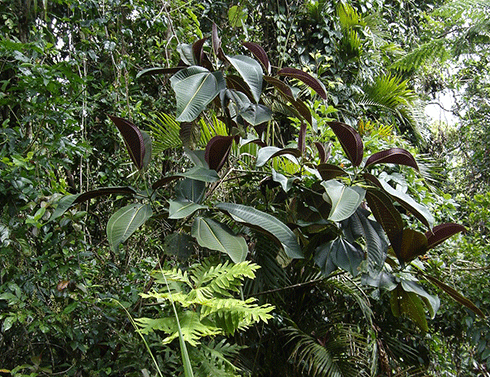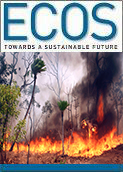
|
Published: 20 October 2014
Plants absorb more CO2 than we thought, but ...
Through burning fossil fuels, humans are rapidly driving up levels of carbon dioxide in the atmosphere, which in turn is raising global temperatures.
But not all the CO2 released from burning coal, oil and gas stays in the air. Currently, about 25 per cent of the carbon emissions produced by human activity are absorbed by plants, and a similar amount ends up in the ocean.
To know how much more fossils fuels we can burn while avoiding dangerous levels of climate change, we need to know how these ‘carbon sinks’ might change in the future. A new study led by Dr Ying Sun and colleagues and just published in the US journal Proceedings of the National Academy of Sciences shows the land could take up slightly more carbon than we thought.
But it doesn’t significantly change how quickly we must decrease carbon emissions to avoid dangerous climate change.
Models overestimate CO2
The new study estimates that over the past 110 years, some climate models over-predicted the amount of CO2 that remains in the atmosphere by about 16 per cent.
Models are not designed to tell us what the atmosphere is doing: that’s what observations are for, and they tell us that the concentration of CO2 in the atmosphere is currently more than 396 parts per million, or about 118 parts per million over levels in pre-industrial times. These atmospheric observations are in fact the most accurate measurements of the carbon cycle.
But models, which are used to understand the causes of change and explore the future, often don’t perfectly match the observations. In this new study, the authors may have come up with a reason that explains why some models overestimate CO2 in the atmosphere.
Looking to the leaves
Plants absorb carbon dioxide from the air, combine it with water and energy from sunlight, and make carbohydrates – the process known as photosynthesis.
It is well established that, as CO2 in the atmosphere increases, the rate of photosynthesis increases. This is known as the CO2 fertilisation effect.
But the new study shows that models may not have quite right the way of simulating photosynthesis. The reasons come down to how CO2 moves around inside a plant’s leaf.
Models use the CO2 concentration inside a plant’s leaf cells, in the so called sub-stomatal cavity, to drive the sensitivity of photosynthesis to increasing amounts of CO2. But this isn’t quite correct.
The new study shows that CO2 concentrations are actually lower inside a plant’s chloroplasts – the tiny chambers of a plant cell where photosynthesis actually happens. This is because the CO2 has to go through an extra series of membranes to get into the chloroplasts.
This means that photosynthesis takes place at lower CO2 than models assume. But counter-intuitively, because photosynthesis is more responsive to increasing levels of CO2 at lower concentrations, plants are removing more CO2 in response to increasing emissions than models show.
Photosynthesis increases as CO2 concentrations increase but only up until a point. At some point more CO2 has no effect on photosynthesis, which stays the same. It becomes saturated.
But if concentrations inside a leaf are lower, this saturation point is delayed, and growth in photosynthesis is higher, which means more CO2 is absorbed by the plant.
The new study shows that when accounting for the issue of CO2 diffusivity in the leaf, the 16 per cent difference between modelled CO2 in the atmosphere and the real observations disappear.
It is a great, neat piece of science, which connects the intricacies of leaf level structure to the functioning of the Earth system. We will need to re-examine the way we model photosynthesis in climate models and whether a better way exists in light of the new findings.
Does this change how much CO2 the land absorbs?
This study suggests that some climate models under-simulate how much carbon is stored by plants, and in consequence over-simulate how much carbon goes into the atmosphere. The land sink might be a little bigger – although we don’t know yet how much bigger.
If the land sink does a better job, it means that for a given climate stabilisation, we would have to do a little less carbon mitigation.
But it is a long, long way from photosynthesis in a leaf to the creation of a true, land-based carbon sink, one that actually stores carbon for a long time.
About 50 per cent of all CO2 taken in by photosynthesis goes back to the atmosphere soon after through plant respiration.
Of what remains, more than 90 per cent also returns to the atmosphere through microbial decomposition in the soils and disturbances such as fire over the following months and years – what stays is the land sink.
Good news, but not time for complacency
The study is a rare and welcome piece of possible good news, but its findings need to be placed in context. The land sink’s sequestration potential has very large uncertainties, which have been well quantified, and qualified with multiple reasons.
Some models suggest that the land will continue to absorb more carbon throughout this century; some predict it will absorb more carbon up to a point; and some predict that the land will start releasing carbon – becoming a source, not a sink.
The reasons are multiple and include the limited information we have on how the thawing of permafrost will affect large carbon reservoirs; how a lack of nutrients in the soil could limit the further expansion of the land sink; and how fire regimes might change under a warmer world.
Put together these uncertainties, when quantified, are many times bigger than the possible effect of the leaf CO2 diffusion. The bottom line is that humans will continue to be in full control of what’s happening to the climate system over the coming centuries, and what we do with greenhouse emissions will largely determine its trajectory.
Dr Pep Canadell is Executive Director of the Global Carbon Project, an effort under the International Council of Science for internationally coordinated research on the carbon cycle and human impacts on the climate system. He is also a research scientist at CSIRO, and scientific advisor to the Australian Government on climate change affairs. This article was originally published on The Conversation.




